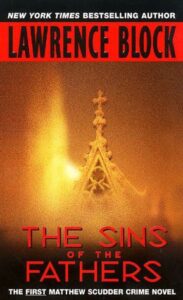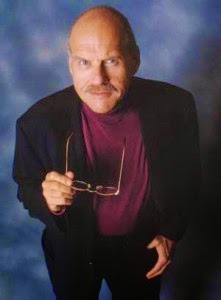by Lawrence Block
 It was an open-and-shut case. NYPD knew it. Ex-cop and unofficial investigator Matthew Scudder knew it. Cale Hanniford, father of the murdered woman, knew it.
It was an open-and-shut case. NYPD knew it. Ex-cop and unofficial investigator Matthew Scudder knew it. Cale Hanniford, father of the murdered woman, knew it.
“I’m not sure that there’s anything I can do for you,” Scudder tells the grieving father. “Your daughter is dead. I can’t change that. The boy who killed her was picked up on the spot. From what I read in the papers, it couldn’t be more open-and-shut if they had the homicide on film.”
What Hanniford really wants to know, he tells Scudder, is who his runaway daughter had become in New York City and why she was killed. (“I have to know how much to blame myself.”) He asks if Scudder understands why it is so important to him.
“I guess I do. The murder was a door starting to open for you. Now you have to know what’s inside the room.”
This is the beginning of author Lawrence Block’s 18-book long series featuring Matthew Scudder. Riddled with guilt about accidentally shooting and killing a seven-year-old girl while he was stopping a crime, Scudder walks away from his job as cop, his marriage and “deliberately restructured [his life] to minimize involvement in the lives of others.”
He lives in a hotel. He wanders from one bar to another. He drinks coffee liberally laced with bourbon. Alcohol is his sidekick in this series from the first cup of coffee and bourbon to the 364th day of his sobriety that is so pivotal in A Drop of the Hard Stuff. From the sixth book, When the Sacred Gin Mill Closes, sobriety rather than his next drink becomes Scudder’s constant companion. That struggle is frequently more interesting than Scudder’s investigations.
Like Lee Child’s protagonist Jack Reacher, Scudder is an unorthodox, antisocial seeker of justice. But where Reacher is consistently certain and unregretful, Scudder is scarred and in pain.
In The Sinners of the Fathers, Scudder never takes the easy way to avoid the truth, although he is compassionate enough to shield the innocent from it. What his investigation shows him is that the case was never what it looked like on the surface. Scudder closes this case in his own relentless, secretive way.
The full series is listed in order below. However, if you wish to read the books in story order, read In the Midst of Death before reading Time to Murder and Create. While the early books are interchangeable, the story development that occurs from Eight Million Ways to Die on makes it better to read them in sequence.
- The Sins of the Fathers (1976)
- Time to Murder and Create (1976). Sharp-sighted Jake “The Spinner” Jablon pays Scudder to find his prospective murderer, when he makes a dangerous career move from informant to blackmailer. When he’s found with a smashed skull floating in the East River, Scudder hits the streets investigating Jablon’s client list.
- In the Midst of Death (1976). Scudder the ex-cop is personally familiar with the graft and payola allowed to exist in the NYPD. But when policeman Jerry Broadfield is charged with extortion and tells all to a committee on police corruption, a dead hooker turns up in his apartment and his accused of murder. Scudder with his unique sense of integrity investigates Broadfield’s claims of a frame-up, in a case that leaves Scudder with as much to watch out for from the cops as from the criminals.
- A Stab in the Dark (1981). The father of murder victim Barbara Ettinger comes to Scudder for help. The man believed to have killed her has been taken into custody by the NYPD and confessed to killing seven young women with an ice pick — but not Barbara. He has a solid alibi to prove he didn’t kill her. Scudder takes on this nine-year-old cold case and refuses to let go even when his client is willing to pay him to stop. In the course of his investigation, he meets and becomes involved with Jan Keane, a sculptress starting to come to terms with her own drinking issues.
- Eight Million Ways to Die (1982). This book ends with Scudder introducing his story at an Alcoholics Anonymous meeting. This was supposed to be the end of the series, but Block had promised an editor friend an original Scudder short story. Block set it during Scudder’s drinking days but told it from the perspective of a recovering alcoholic. He expanded on the idea in When the Sacred Ginmill Closes, one of Block’s own favorites.
- When the Sacred Ginmill Closes (1986). The title of this book comes from the lyrics of a Dave Van Ronk song, “Last Call.” This book involves three crimes — the hold-up of an illegal, after hours bar run by a pair of Irish brothers; the murder of one of Scudder’s drinking buddies’ wife; and the blackmail of another of Scudder’s drinking pals, a bar owner who kept two sets of books, one clean and one altered to hide skimming and reduce taxes. The story is a dark tale of how the alcohol is taking over Scudder’s life and an equally dark story of cold vengeance. At the end of the book, Scudder says, “. . . everything is different now. Everything. All changed, changed utterly. I live in the same hotel, I walk the same streets, I go to a fight or a ball game the same as ever, but 10 years ago, I was always drinking and now I don’t drink at all. I don’t regret a single one of the drinks I took, and I hope to God I never take another. Because that, you see, is the less-traveled road on which I find myself these days, and it has made all the difference. Oh, yes. All the difference.”
- Out on the Cutting Edge (1989). An assignment to find would-be actress Paula Hoeldtke takes Scudder through the dark, dirty world of Hell’s Kitchen.
- A Ticket to the Boneyard (1990). In this book, Scudder encounters Elaine Mardell, a hooker he met when he was a cop, and she becomes an on-going character.
- A Dance at the Slaughterhouse (1991). Pay-back time arrives when psycho James Leo Motley is released from prison. Scudder, who lied to a jury to get him behind bars, now has to watch his back — and his friends.
- A Walk Among the Tombstones (1992), which was made into a movie starring Liam Neeson as Scudder and released in 2014. In this book, he struggles with the fact of Elaine’s prostitution, as well as sobriety and a pair of violent kidnappers.
- The Devil Knows You’re Dead (1993). Was it a random act of violence when a deranged Vietnam veteran shot successful young Glenn Holtzmann? Thomas Sadecki, brother of the accused veteran, thinks the police have arrested the wrong man. Scudder knows that innocence is relative.
- A Long Line of Dead Men (1994). An exclusive club of 30 men has been meeting annually for years. As a member dies, he is replaced with a new member. But when they start to die at an alarming rate, Scudder is brought in to find out why. A world away from the gutters and alleys where Scudder usually works, the case forces him to look to look at what gives his own life meaning. In this book, Elaine and Scudder get married.
- Even the Wicked (1997). Scudder, who has had his own brushes with playing god in his investigations, now faces bringing down New York’s latest serial killer, a so-called vigilante who calls himself “The Will of the People” and targets child molesters, mafiosos and others.
- Everybody Dies (1998). Throughout the series, Scudder meditates on the randomness and insanity of crime, the tiny irritants that lead to murder, criminal overreactions. This book opens with a prettier, more civilized New York of gentrification, falling crime rates and a generous economy. That turns out to be a veneer for Scudder when his latest case takes him into an urban war zone where “nothing is certain and nobody’s safe.”
- Hope to Die (2001). The citizens and the cops give a sigh of relief when two men, the suspected killers of an upscale couple who were slaughtered in a brutal home invasion, are found dead. Scudder is alone is suspecting there’s a third man at large preparing to repeat the crime.
- All the Flowers Are Dying (2005). Matt and his wife Elaine becomes the targets of a vicious killer.
- A Drop of the Hard Stuff (2011). Much of this book deals with the challenges Scudder faces as his first anniversary of being sober approaches. It, like When the Sacred Ginmill Closes, is told as a flashback to an earlier time. He is attempting to solve the murder of a fellow AA member who may have been killed by one of the people he was sponsoring.His relationship with Jan Keane flickers out in this book.
- The Night and the Music (2013) (A collection Matthew Scudder short stories and mini-novels)
The Author
Since 1994, Block has been a Grand Master of the Mystery Writers of America in 1994.
He began writing in the 1950s, but under a variety of pseudonyms. It wasn’t until 1957 that he started writing under his own name, the short story “You Can’t Lose.” The first book published under his name was Mona (1961). He has published more than 50 novels, more than 100 short stories and a series of books about writing for writers.
In addition, to the Matthew Scudder series, he has written a number of other series, including one featuring the gentleman burglar Bernie Rhodenbarr.



